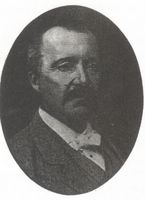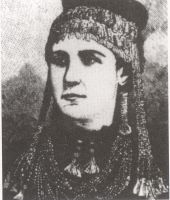It befell an adventurous businessman, Heinrich Schliemann,

to dispel the myth and prove that Troy in fact existed. Born in Germany in 1822, he took a job in Amsterdam, mastered several languages, became a wealthy merchant in Russia, and took up archaeology as a serious hobby in Paris. After a divorce he married a Greek girl and moved to Athens; there Greek legends and myths began to guide his archaeological interests. Traveling extensively in the Hellenic zone, he accepted suggestions made by others that a site named Hissarlik at the tip of Asia Minor, on the eastern shores of the Straits of Dardanelles, was the location of ancient Troy.
Financing excavations with his own funds, he oversaw archaeological work at the site for almost two decades, beginning in 1870 until his death in 1890, when the work was continued by his assistant Wilhelm Dorpfeld. Schliemann’s own excavations unearthed several successive levels of occupation at Troy, evidence of the city’s fall at a time correlating with Homer’s tale, and artifacts testifying to the city’s opulence and period. A necklace, tiara, and other royal jewelry named King Priam’s Treasure by Schliemann were gifted by him to his wife to wear in public.

Schliemann’s discoveries at Troy, which he carefully documented and artfully publicized, did not result in the immediate appreciation that he expected. The scholarly establishment resented the intrusion into their realm by a self-appointed archaeologist. Few were ready to part with the notion that Homer’s tale was just a myth. Accusations were made that Schliemann faked evidence, that some artifacts were really from other places. Even when, digging in Greece proper, he proved Homer right by uncovering ancient Mycenae and a royal tomb which he claimed was that of Agamemnon, he was still derided. A golden mask that he suggested was the death mask ofAgamemnon was dismissed as a modern fake. [....]
In spite of all that, many now consider Schliemann the Father of modern archaeology. Archaeologists now retain no doubt whatsoever that the site of Hissarlik is indeed the site of ancient Troy, and that in that respect Homer’s tale was no myth. That Troy was destroyed, in the thirteenth century B.C. by siege and war, is also undisputed, though no one can say nowadays whether it was really about the beautiful Helen—or due to the wish of the god Zeus to lessen Earth’s burden by getting some tribes of Mankind done away with.
Yet that is precisely why I chose to start the Expedition to Turkey with a visit to Troy; for, if Homer was right about there having been a city of Troy, and if Troy was in fact destroyed in a war, and if its treasures matched the Bronze Age period indicated by Homer, why doubt the rest of his tale—that not only men but also gods were involved in the conflict?
As the Expedition took the group to other exciting sites in Turkey, such as those of the Hittites or of Assyrian trading colonies, or to museums where artifacts from those past civilizations are kept, the reference to “gods” in inscribed texts and their depictions in countless monuments were omnipresent. As often as not, the depictions showed the gods as towering over their favored human kings. The gods are distinguished by their horned helmets or other garments or footwear, or by the hieroglyph for “divine” or by the title “god” preceding their personal inscribed names.
To the ancient peoples, the “gods” were real, physically present. Without accepting that, traveling from one archaeological site or museum to another was, I felt, an exercise in futility. Having read my books, my group already knew that all the tales of gods hark back to the millennia-old Sumerian tales of the Anunnaki, "Those who from Heaven to Earth came."
(The Earth Chronicles Expeditions: Journeys to the Mythical Past
By Zecharia Sitchin :7-8)
Ruins of Troy:
Depictions of the gods:
(The Nephilim and the Pyramid of the Apocalypse
By Patrick Heron :92)
The head of a normal size person seems to come to just above the knee of what ancients depicted as "the gods" or perhaps "the giants" that the Israelites were called to kill. David vs. Goliath, etc. But anyway, it seems to me that having an ancient philosopher, historian or other type of scholar write of "the gods" as if they had an impact on their national history and so on would be like a modern historian writing, "Then Superman came down from the sky and decided who would be president..." It is possible that a scholar would write such things if they were taking artistic license. But typically, art goes with art and is easily refuted as a matter of fact instead of being mixed throughout otherwise sound scholarship and history.
Jesus, on a god like lightning:
The seventy-two returned with joy and said, "Lord, even the demons submit to us in your name."
He replied, "I saw Satan fall like lightning from heaven. I have given you authority to trample on snakes and scorpions and to overcome all the power of the enemy; nothing will harm you. However, do not rejoice that the spirits submit to you, but rejoice that your names are written in heaven."
Note how he says, "...do not rejoice that the spirits submit to you..." although he just mentioned real creatures such as snakes and scorpions, literal/physical things. There are those lacking in spiritual discernment who therefore lack any discernment of metaphors who focus on literal/physical snakes and scorpions. That's not what Jesus was saying.
Although biblically, are metaphors literalized sometimes? Of course, as the Word became flesh, it is just that even people who have studied literature, words, writ and law all of their lives may not understand the way in which a line between the Platonic world of the Forms and the literal world may be crossed.
Perhaps those who can transfigure into the "Heaven between heavens..." know more. It would figure that you cannot figure some things out. But it is interesting to think about.

No comments:
Post a Comment